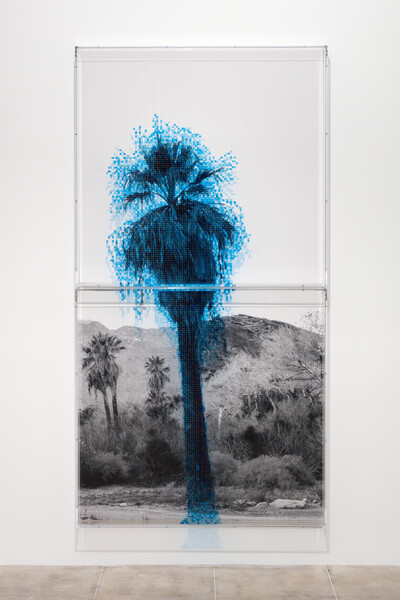
Charles Gaines
Palm Trees and Other Works
14 September - 5 January 2020
Los Angeles
Beginning 14 September, Hauser & Wirth will present ‘Palm Trees and Other Works,’ its first exhibition with Charles Gaines, noted American artist, educator, and recipient of the 2019 Edward MacDowell Medal. This exhibition will debut new works from his signature Gridworks series. Employing native trees from Palm Canyon near Palm Springs, these luminous works have evolved from Gaines’s rigorous application of his numbered systems – a process central to an esteemed, decades-long practice that interrogates the relationship between the object and its subjective realms. Gaines will also present a new series of watercolors based on assorted trees as well as ‘Manifestos 3’ (2018), the latest contribution to a series from which earlier examples reside in the permanent collections of The Museum of Modern Art, New York, and Hammer Museum, Los Angeles.
A pivotal figure in the field of conceptual art, Gaines has long employed a generative process to create series of works in a variety of mediums. By creating space between a specific symbol and the systems applied to its representation through measurable values of color, Gaines’s distinctive approach forges a critical link between first generation American conceptualists like Sol LeWitt and subsequent generations of artists, including Gaines’s students Edgar Arcenaux, Andrea Bowers, Mark Bradford, and Sam Durant, among others who are pushing the limits of conceptualism today. Speaking about his longstanding commitment to unveiling the paradoxes of human visual understanding, Gaines said, ‘The system has never changed, but the outcome is always different.’
On the occasion of this landmark exhibition and in keeping with his revered status among California’s practicing artist academics as a faculty member at CalArts, Gaines will transform The Book & Printed Matter Lab at Hauser & Wirth Los Angeles into a classroom, bringing his mastery of the field into a public setting. He will conduct a ten-part lecture series on the tenets of aesthetics and critical theory in art, with his lectures recorded and played on loop throughout the course of the exhibition. Additionally, Hauser & Wirth Publishers will release a new monograph on Gaines with contributing text by David Platzker and interview by Cherise Smith that charts the evolution of the palm tree in his work from the 1980s to the present.
About the Exhibition Images of trees have figured prominently in Gaines’s practice since the mid-1970s, when he first began plotting their forms through systems of numbered grids in the series Walnut Tree Orchard (1975 – 2014). His methodical examination continues in the Numbers and Trees Plexiglas series, which began in 1987. Here, Gaines selectively layers paint on acrylic sheets atop black and white photographs of corresponding landscapes with trees. Following this process, each tree is assigned a distinctive color and a numbered grid that reflects the positive space of the tree in the original photographic image. The majesty of the process accrues in the completed painting, where breathtakingly complex layers of representation collapse into a single image.
‘Palm Trees and Other Works’ will feature Numbers and Trees: Palm Canyon, Palm Trees Series 2. Standing at nine and twelve feet high, these ten Plexiglas works adhere to Gaines’s signature process dating back to the 1980s: a black and white photograph provides the background for two, vertically stacked acrylic boxes on which he has meticulously plotted numbers and colors within a gridded framework, forming the image of his subject as prescribed by his process. Eliminating any gestural quality or presence of the artist’s hand, Gaines favors a sober presentation of his subject: he does not imagine reality, he evidences it.
The presence of the photograph underscores the indexical quality of Gaines’s work, as seen in ‘Numbers and Trees: Palm Canyon, Palm Trees Series 2, Tree #2, Cupeño’ (2019) and ‘Numbers and Trees: Palm Canyon, Palm Trees Series 2, Tree #4, Kumeyaay’ (2019). Gaines provides the template from which the systematically abstracted subject is drawn. These works require intense participation on the part of the viewer: seen from far away, swaths of colors and numbers form a cohesive image, yet these component parts only become visible upon closer inspection, thus illuminating the difference between Gaines’s system and the subject manifested by it.
The South Gallery’s Mezzanine level will host the largest compilation of Gaines’s watercolors to date, with four works each comprised of a grid of twelve assorted trees, assigned a distinct color: red, blue, green and magenta. Gaines’s artistic orthodoxy loosens in his watercolors: instead of collapsing multiple trees onto a single plane, each sheet features a single tree meticulously composed of tiny painted cells–an artistic codex in and of themselves. Each grid of twelve breaks down the multitude of layers that comprise the larger works exhibited on the main floor below.
Reflecting on his personal history, Gaines observed that ‘one thing that made me different from other conceptual artists is that I was not shying away from language or meaning or content’ – a truth perhaps best exemplified by ‘Manifestos 3’ (2018). This work functions as a systematic transliteration of revolutionary manifestos into musical notation. The installation is comprised of two parts: a single channel video monitor that scrolls the manifesto texts, and two large graphite drawings of the music scores that were produced by the translation. Each text scrolls in succession on a monitor while a recording of the music produced by Gaines’s system plays. Created by way of a rule-based system, Gaines transcribes letters ‘A - H’ from the text into their equivalent musical notes. The use of the letter ‘H’ represents the code used in early Baroque tradition for B-flat. All other letters and spaces between words are noted as rests or silent beats. While the resulting composition does sound intentional, it is controlled only by the preconceived notation system that follows the compositional structure of language. This produces the fluidity that the audience hears.
The two political texts transcribed in ‘Manifestos 3’ are Martin Luther King, Jr.’s speech given at the University of Newcastle upon Tyne (1967), wherein King nominates racism, poverty, and war as the three most urgent problems of the contemporary world, and James Baldwin’s essay ‘Princes and Powers’ (1957) which describes the dominating power of cultural control. These two manifestos are systematically translated into the above described musical notations as written and arranged for piano by Gaines and edited by John Eagle.
This series not only takes social justice and politics on as its subject, but also as it may critique our understanding of the relationship of the practice of art and politics. By converting these powerful and poignant texts into music, Gaines unites the rational, mathematical, and lyrical structures of music with the irrationality of violence, racial tensions, and social injustice. The predetermined process developed by Gaines widens the distance between concepts and their interpretation, effectively removing the artist’s subjectivity while empowering the viewer’s. The combination of the elegiac music with the stirring words of the scrolling manifestos creates an unexpected conflict for the viewer; it is within this dissonance that the indelible truths of Gaines’s work are revealed.
Selected images
Installation views





















1 / 9
Related Content
About the Artist

Charles Gaines
A pivotal figure in the field of conceptual art, Charles Gaines’ body of work engages formulas and systems that interrogate relationships between the objective and the subjective realms. Using a generative approach to create a series of works in a variety of mediums, he has built a bridge between the early conceptual artists of the 1960s and 1970s and subsequent generations of artists pushing the limits of conceptualism today.
Born in 1944 in Charleston, South Carolina, Gaines began his career as a painter, earning his M.F.A. from the School of Art and Design at the Rochester Institute of Technology in 1967. In the 1970s, Gaines’ art shifted dramatically in response to what he would later call ‘the awakening.’ Gaines’ epiphany materialized in a series called Regression (1973 – 1974), in which he explored the use of mathematical and numeric systems to create soft, numbered marks in ink on a grid, with each drawing built upon the calculations of the last. This methodical approach would carry the artist into the subsequent decades of his artistic journey.
Working both within the system and against it, Gaines points to the tensions between the empirical objective and the viewers’ subjective response. The concept of identity politics has played a central role within Gaines’ oeuvre, and the radical approach he employs addresses issues of race in ways that transcend the limits of representation.
Gaines lives and works in Los Angeles. He has been the subject of numerous exhibitions in the United States and around the world, most notably a major traveling survey at The Institute of Contemporary Art, Miami; a mid-career survey at the Pomona College Museum of Art and the Pitzer College Art Gallery in Claremont CA; a museum survey of early works at The Studio Museum, Harlem NY and the Hammer Museum, Los Angeles CA; and presentations at the 1975 Whitney Biennial and the Venice Biennale in 2007 and 2015. An exhibition of his work is also currently on long-term view at Dia:Beacon in New York. In 2022, Gaines launched his most ambitious public art project yet, ‘The American Manifest,’ presented by Creative Time, Governors Island and Times Square Arts. The third and final chapter of ‘The American Manifest,’ organized by Creative Time, will travel to the banks of the Ohio River in June 2025. Additional forthcoming public commissions include the mural ‘Numbers and Trees: Cincinnati Cottonwoods,’ organized by Cincinnati nonprofit ArtWorks (June 2025); ‘Hanging Tree’ at Equal Justice Initiative’s Freedom Monument Sculpture Park in Montgomery AL (June 2025); and a new work for the Intuit Dome in Inglewood CA (spring 2026). Gaines will be an artist-in-residence at Hauser & Wirth Somerset in spring 2025 and a book of his collected writings will be released by Hauser & Wirth Publishers in spring 2026.
In addition to his artistic practice, Gaines was on the faculty at CalArts School of Art for over 30 years, establishing a fellowship to provide critical scholarship support for Black students in the M.F.A. Art program. He has published several essays on contemporary art, including ‘Theater of Refusal: Black Art and Mainstream Criticism’ (University of California, Irvine, 1993) and ‘The New Cosmopolitanism’ (California State University, Fullerton, 2008). In 2019, Gaines received the 60th Edward MacDowell Medal. He was inducted into the National Academy of Design’s 2020 class of National Academicians and the American Academy of Arts and Letters in May 2022. In 2023, he received an honorary doctorate from his alma mater, the Rochester Institute of Technology in New York.
Gaines’ work is included in prominent public collections such as the Museum of Modern Art, New York NY; Whitney Museum of American Art, New York NY; The Studio Museum, Harlem NY; Hirshhorn Museum and Sculpture Garden, Washington DC; Museum of Contemporary Art, Chicago IL; Hammer Museum, Los Angeles CA; Los Angeles County Museum of Art, Los Angeles CA; Museum of Contemporary Art, Los Angeles CA; San Francisco Museum of Modern Art, San Francisco CA; and Tate, London, UK.
Current Exhibitions
1 / 12

















